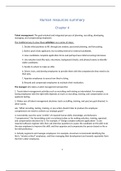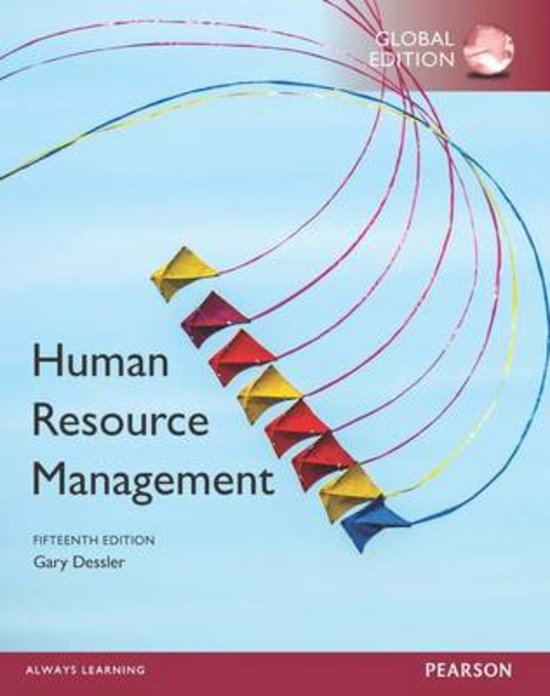Human resources summary
Chapter 4
Talent management: The goal-oriented and integrated process of planning, recruiting, developing,
managing, and compensating employees
The traditional way to view these activities is as a series of steps:
1. Decide what positions to fill, through job analysis, personnel planning, and forecasting.
2. Build a pool of job applicants, by recruiting internal or external candidates.
3. Have candidates complete application forms and perhaps have initial screening interviews.
4. Use selection tools like tests, interviews, background checks, and physical exams to identify
viable candidates.
5. Decide to whom to make an offer.
6. Orient, train, and develop employees to provide them with the competencies they need to do
their jobs.
7. Appraise employees to assess how they're doing.
8. Reward and compensate employees to maintain their motivation.
The manager who takes a talent management perspective:
1. Treats talent management activities such as recruiting and training as interrelated. For example,
having employees with the right skills depends as much on recruiting, training, and compensation as on
applicant testing.
2. Makes sure all talent management decisions (such as staffing, training, and pay) are goal directed. In
other words,
ask, "What recruiting, testing, training, or pay action should I take to produce the employee
competencies we need to achieve our strategic goals?"
3. Consistently uses the same "profile" of required human skills, knowledge, and behaviors
("competencies") for formulating a job's recruitment plans as for making selection, training, appraisal,
and compensation decisions for it. For example, if "Design complex software applications" is one
required software engineer skill, then ask interview questions to assess the candidate on this skill; train
the new employee to improve this skill; and then appraise and compensate the person based on his or
her skill proficiency.
4. Actively segments and manages employees. For example, Accenture recommends identifying the
firm's "mission critical" employees, and then managing their development and rewards separately from
the firm's other employees.
1
,5. Actively coordinates or integrates the ongoing talent management functions such as recruiting and
training. For example, HR managers meet to make sure they are using the same skills profile to recruit as
to select, train, and appraise for a particular job, or use special talent management software to do so.
Job analysis: The procedure for determining the duties and skill requirements of a job and the kind of
person who should be hired for it.
Job description: A list of a job's duties, responsibilities, reporting relationships, working conditions, and
supervisory responsibilities-one product of a job analysis.
Job specification: A list of a job's "human requirements," that is, the requisite education, skills,
personality, and so on-another product of a job analysis
The supervisor or human resources specialist normally collects one or more of the following types of
information via the job analysis:
Work activities. Information about the job's actual work activities, such as cleaning, selling,
teaching, or painting. This list may also include how, why, and when the worker performs each
activity.
Human behaviors. Information about human behaviors the job requires, like sensing,
communicating, lifting weights, or wall<.ing long distances.
Machines, tools, equipment, and work aids. Information regarding tools used, materials
processed, knowledge dealt with or applied (such as finance or law), and services rendered
(such as counseling or repairing).
Performance standards. Information about the job's performance standards (in terms of
quantity or quality levels for each job duty, for instance).
Job context. Information about such matters as physical working conditions, work schedule,
incentives, and, for instance, the number of people with whom the employee would normally
interact.
Human requirements. Information such as lmowledge or skills (education, training, work
experience) and required personal attributes (aptitudes, personality, interests).
Uses of job analysis information
Recruitment and selection: Information about what duties the job entails and what human
characteristics are required to perform these activities helps managers decide what sort of people to
recruit and hire.
EEO compliance: Job analysis is crucial for validating all major human resources practices. For example,
to comply with the Americans with Disabilities Act, employers should know each job's essential job
functions-which in turn requires a job analysis.
Performance appraisal: A performance appraisal compares each employee's actual performance with his
or her duties and performance standards. Managers use job analysis to learn what these duties and
standards are.
2
,Compensation: Compensation (such as salary and bonus) usually depends on the job's required skill and
education level, safety hazards, degree of responsibility, and so on-all factors you assess through job
analysis.
Training: The job description lists the job's specific duties and requisite skills-thus pinpointing what
training the job requires.
Conducting Job Analysis
1. How will the information be used?
2. Background information
3. Representative positions
4. Collect and analyze data
5. Verify
6. Create job description and specification (using the right format)
Organization chart: A chart that shows the organization wide distribution of work, with titles of each
position and interconnecting lines that show who reports to and communicates with whom.
Process chart: A workflow chart that shows the flow of inputs to and outputs from a particular job.
Workflow analysis: A detailed study of the flow of work from job to job in a work process.
Business reengineering: Redesigning business processes, usually by combining steps, so that small
multifunction process teams using information technology do the jobs formerly done by a sequence of
departments.
The basic reengineering approach is to
1. Identify a business process to be redesigned (such as processing an insurance claim)
2. Measure the performance of the existing processes
3. Identify opportunities to improve these processes
4. Redesign and implement a new way of doing the work
5. Assign ownership of sets of formerly separate tasks to an individual or a team who use new
computerized systems to support the new arrangement
Job enlargement: Assigning workers additional same-level activities.
Job rotation: Systematically moving workers from one job to another.
Job enrichment: Redesigning jobs in a way that increases the opportunities for the worker to experience
feelings of responsibility, achievement, growth, and recognition.
3
, Robbins CH15
Organizational structure: The way in which job tasks are formally divided, grouped, and coordinated.
Work specialization: The degree to which tasks in an organization are subdivided into separate jobs.
Departmentalization: The basis by which jobs in an organization are grouped together.
Chain of command: The unbroken line of authority that extends from the top of the organization to the
lowest echelon and clarifies who reports to whom.
Authority: The rights inherent in a managerial position to give orders and to expect the orders to be
obeyed.
Unity of command: The idea that a subordinate should have only one superior to whom he or she is
directly responsible
Span of control: The number of subordinates a manager can efficiently and effectively direct.
Centralization: The degree to which decision making is concentrated at a single point in an organization
Formalization: The degree to which jobs within an organization are standardized.
Boundary spanning: When individuals form relationships outside their formally assigned groups.
Common Organizational Frameworks and Structures
Simple structure: An organizational structure characterized by a low degree of departmentalization,
wide spans of control, authority centralized in a single person, and little formalization.
Bureaucracy: An organizational structure with highly routine operating tasks achieved through
specialization, very formalized rules and regulations, tasks that are grouped into functional
4






